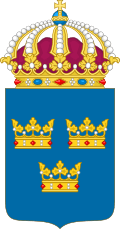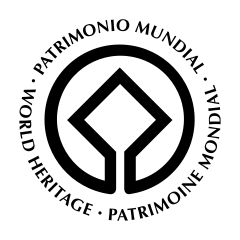List of World Heritage Sites in Sweden
The United Nations Educational, Scientific and Cultural Organization (UNESCO) World Heritage Sites are places of importance to cultural or natural heritage as described in the UNESCO World Heritage Convention, established in 1972.[1] The Kingdom of Sweden accepted the convention on 22 January 1985, making its historical sites eligible for inclusion on the list. As of 2016, there are fifteen World Heritage Sites in Sweden, including thirteen cultural sites, one natural site and one mixed site.[2]

There are two transnational sites. The High Coast / Kvarken Archipelago is shared with Finland while the Struve Geodetic Arc is shared with nine other countries.[2] As of 2020, Sweden also has one property on the tentative list.[2]
World Heritage Sites
UNESCO lists sites under ten criteria; each entry must meet at least one of the criteria. Criteria i through vi are cultural, whereas vii through x are natural.[3]
| Site | Image | Location | Year listed | UNESCO data | Description |
|---|---|---|---|---|---|
| Royal Domain of Drottningholm | 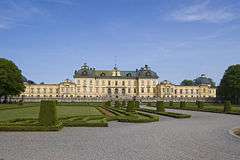 |
Stockholm | 1991 | 559; iv (cultural) | The Drottningholm Palace is the private residence of the Swedish royal family, located on an island Lovön in Lake Mälaren in a suburb of Stockholm. The palace ensemble dates back to the 17th and 18th century, and includes the still-functioning Theatre, a Chinese Pavilion, a Canton Village, and surrounding gardens. The rich interiors of the palace reflect the fact that Sweden was one of the strongest powers in the 17th century Europe. The architecture of the ensemble can be viewed as the legacy of the influences of the Palace of Versailles.[4] |
| Birka and Hovgården | 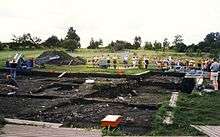 |
Stockholm | 1993 | 555; iii, iv (cultural) | The two sites make up an architectural complex from the Viking Era. Birka was an important mercantile town and a commercial hub in the Baltic region that reached its peak between 750 and 980 AD. It was also the site of the first Christian congregation in Sweden, established by Saint Ansgar around 830. Birka declined in the 10th century when the central function shifted to Sigtuna. Nevertheless, the royal residence remained at nearby Hovgården, as demostrated by the runic inscription and the ruins of Alsnö hus, the venue for the Royal Council of 1280, which established the foundation of the Swedish medieval feudal system.[5] |
| Engelsberg Ironworks | 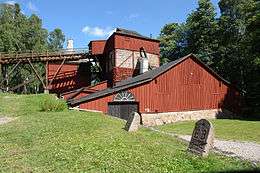 |
Västmanland | 1993 | 556; iv (cultural) | [6] |
| Rock Carvings in Tanum |  |
Västra Götaland | 1994 | 557; i, iii, iv (cultural) | The petroglyphs carved on a granite bedrock originate from the Nordic Bronze Age (from about 1700 to 500 BCE). They depict humans, animals, weapons, tools, and other subjects. There are around 1500 known sites with carvings. They reveal the life and beliefs of people who made them, and some settings were interpreted as primary contemporary centres for worship and cult.[7] Some carvings have been painted red to make them more visible for tourists; a practice which has drawn criticism for removing the authenticity and original state of the drawings.[8][9] |
| Skogskyrkogården |  |
Stockholm | 1994 | 558; ii, iv (cultural) | [10] |
| Hanseatic Town of Visby | Gotland | 1995 | 731; iv, v (cultural) | [11] | |
| Church Town of Gammelstad, Luleå | Norrbotten | 1996 | 762; ii, iv, v (cultural) | [12] | |
| Laponian Area | 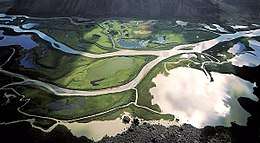 |
Norrbotten | 1996 | 774; iii, v, vii, viii, ix (mixed) | [13] |
| Naval Port of Karlskrona | 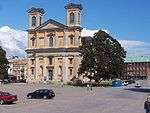 |
Blekinge | 1998 | 871; ii, iv (cultural) | [14] |
| Agricultural Landscape of Southern Öland | 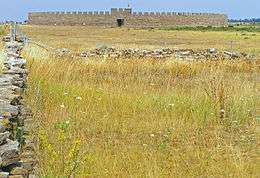 |
Kalmar | 2000 | 968; iv, v (cultural) | [15] |
| High Coast / Kvarken Archipelago* | 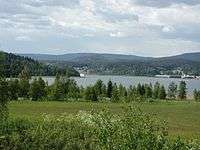 |
Västernorrland | 2000 | 898; viii (natural) | Both the High Coast (originally listed individually) and the Kvarken Archipelago (in Finland, extended in 2006) are situated in the Gulf of Bothnia and include thousands of islands. The area shows prominent effects of the post-glacial rebound, the rising of the land following the melting of the continental ice sheet after the Last Glacial Maximum (thus removing the weight of the glaciers), 10,000 to 24,000 years ago. The rising, in some places up to almost 300 metres (980 ft), is constantly changing the landscape.[16] |
| Mining Area of the Great Copper Mountain in Falun | 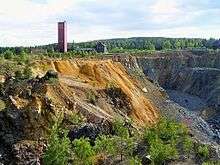 |
Dalarna | 2001 | 1027; ii, iii, v (cultural) | [17] |
| Grimeton Radio Station, Varberg |  |
Halland | 2004 | 1134; ii, iv (cultural) | Grimeton Radio Station is an early longwave transatlantic wireless telegraphy station built in 1922-24. The site comprises of the main buildings, designed in the Neoclassical style by the architect Carl Åkerblad, and the antenna towers, which at 127 metres (417 ft) were the tallest structures in Sweden when constructed. The station, which uses the early pre-electronic radio transmitter technology called an Alexanderson alternator, is still fully operational.[18] |
| Struve Geodetic Arc* |  |
Norrbotten | 2005 | 1187; ii, iii, vi (cultural) | The Struve Geodetic Arc is a series of triangulation points, stretching over a distance of 2,820 kilometres (1,750 mi) from Hammerfest in Norway to the Black Sea. The points were set up in a survey by the astronomer Friedrich Georg Wilhelm von Struve who first carried out an accurate measurement of a long segment of a meridian, which helped to establish the size and shape of the Earth. Originally, there were 265 station points. The World Heritage Site includes 34 points in ten countries (north to south: Norway, Sweden, Finland, Russia, Estonia, Latvia, Lithuania, Belarus, Moldova, Ukraine), four of which are in Sweden (Jupukka hill, one of the Sweden's station points pictured).[19] |
| Decorated Farmhouses of Hälsingland | 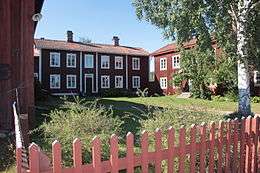 |
Gävleborg | 2012 | 1282; v (cultural) | [20] |
Tentative sites
In addition to sites inscribed on the World Heritage List, member states can maintain a list of tentative sites that they may consider for nomination. Nominations for the World Heritage List are only accepted if the site was previously listed on the tentative list. As of 2016, Sweden recorded one site on its tentative list.[21]
| Site | Image | Location | Year listed | UNESCO criteria | Description |
|---|---|---|---|---|---|
| The Rise of Systematic Biology | 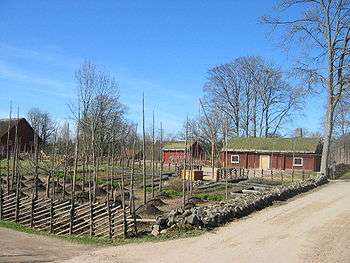 |
Kronoberg and Uppsala | 2009 | vi (cultural) | Swedish components associated with Carl Linnaeus include Råshult, Linnaean Garden, Linnaean Museum, Herbationes Upsalienses, Hågadalen-Nåsten Nature Reserve, Fäbodmossen Nature Reserve, Årike Fyris and Linnaeus' Hammarby.[22] |
References
- "The World Heritage Convention". UNESCO. Retrieved 21 September 2010.
- "Sweden". UNESCO. Retrieved 26 May 2011.
- "UNESCO World Heritage Centre – The Criteria for Selection". UNESCO World Heritage Centre. Archived from the original on 12 June 2016. Retrieved 17 August 2018.
- https://whc.unesco.org/en/list/559
- https://whc.unesco.org/en/list/555
- "Engelsberg Ironworks". UNESCO. Retrieved 26 May 2011.
- "Rock Carvings in Tanum". UNESCO. Retrieved 26 May 2011.
- Gustafsson, Anders; Karlsson, Håkan (Autumn 2008). "Places of Power: Control, Public Access and Authenticity at Rock Carvings in Tanum, Sweden and Val Camonica, Italy". Public Archaeology. 7 (3): 174–198.
- Douglas Price, Theron (2013). Europe Before Rome. OUP USA. p. 284. ISBN 0199914702.
- "Skogskyrkogården". UNESCO. Retrieved 26 May 2011.
- "Hanseatic Town of Visby". UNESCO. Retrieved 26 May 2011.
- "Church Village of Gammelstad, Luleå". UNESCO. Retrieved 26 May 2011.
- "Laponian Area". UNESCO. Retrieved 26 May 2011.
- "Naval Port of Karlskrona". UNESCO. Retrieved 26 May 2011.
- "Agricultural Landscape of Southern Öland". UNESCO. Retrieved 26 May 2011.
- "High Coast / Kvarken Archipelago". UNESCO World Heritage Centre. Archived from the original on 17 October 2011. Retrieved 20 October 2011.
- "Mining Area of the Great Copper Mountain in Falun". UNESCO. Retrieved 26 May 2011.
- https://whc.unesco.org/en/list/1134
- "Struve Geodetic Arc". UNESCO World Heritage Centre. Archived from the original on 18 October 2011. Retrieved 20 October 2011.
- "Decorated Farmhouses of Hälsingland". UNESCO. Retrieved 3 July 2012.
- "Tentative Lists". UNESCO. Retrieved 26 May 2011.
- "The Rise of Systematic Biology". UNESCO. Retrieved 26 May 2011.
- "Varberg Radio Station". UNESCO. Retrieved 26 May 2011.
